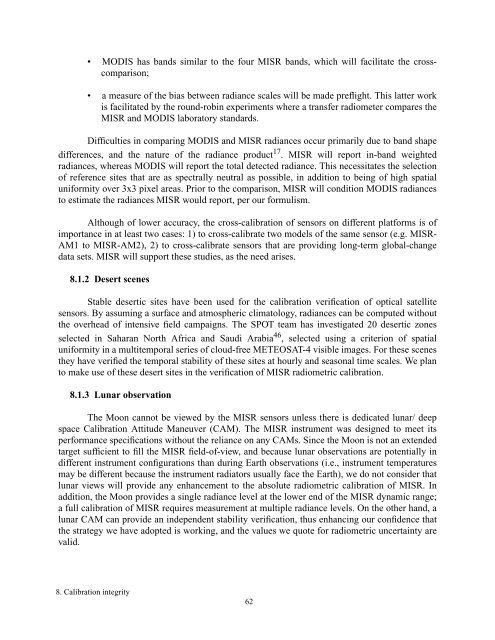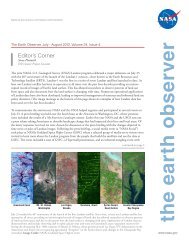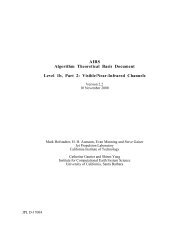MISR: In-Flight Radiometric Calibration and Characterization Plan
MISR: In-Flight Radiometric Calibration and Characterization Plan
MISR: In-Flight Radiometric Calibration and Characterization Plan
You also want an ePaper? Increase the reach of your titles
YUMPU automatically turns print PDFs into web optimized ePapers that Google loves.
• MODIS has b<strong>and</strong>s similar to the four <strong>MISR</strong> b<strong>and</strong>s, which will facilitate the crosscomparison;• a measure of the bias between radiance scales will be made preflight. This latter workis facilitated by the round-robin experiments where a transfer radiometer compares the<strong>MISR</strong> <strong>and</strong> MODIS laboratory st<strong>and</strong>ards.Difficulties in comparing MODIS <strong>and</strong> <strong>MISR</strong> radiances occur primarily due to b<strong>and</strong> shapedifferences, <strong>and</strong> the nature of the radiance product 17 . <strong>MISR</strong> will report in-b<strong>and</strong> weightedradiances, whereas MODIS will report the total detected radiance. This necessitates the selectionof reference sites that are as spectrally neutral as possible, in addition to being of high spatialuniformity over 3x3 pixel areas. Prior to the comparison, <strong>MISR</strong> will condition MODIS radiancesto estimate the radiances <strong>MISR</strong> would report, per our formulism.Although of lower accuracy, the cross-calibration of sensors on different platforms is ofimportance in at least two cases: 1) to cross-calibrate two models of the same sensor (e.g. <strong>MISR</strong>-AM1 to <strong>MISR</strong>-AM2), 2) to cross-calibrate sensors that are providing long-term global-changedata sets. <strong>MISR</strong> will support these studies, as the need arises.8.1.2 Desert scenesStable desertic sites have been used for the calibration verification of optical satellitesensors. By assuming a surface <strong>and</strong> atmospheric climatology, radiances can be computed withoutthe overhead of intensive field campaigns. The SPOT team has investigated 20 desertic zonesselected in Saharan North Africa <strong>and</strong> Saudi Arabia 46 , selected using a criterion of spatialuniformity in a multitemporal series of cloud-free METEOSAT-4 visible images. For these scenesthey have verified the temporal stability of these sites at hourly <strong>and</strong> seasonal time scales. We planto make use of these desert sites in the verification of <strong>MISR</strong> radiometric calibration.8.1.3 Lunar observationThe Moon cannot be viewed by the <strong>MISR</strong> sensors unless there is dedicated lunar/ deepspace <strong>Calibration</strong> Attitude Maneuver (CAM). The <strong>MISR</strong> instrument was designed to meet itsperformance specifications without the reliance on any CAMs. Since the Moon is not an extendedtarget sufficient to fill the <strong>MISR</strong> field-of-view, <strong>and</strong> because lunar observations are potentially indifferent instrument configurations than during Earth observations (i.e., instrument temperaturesmay be different because the instrument radiators usually face the Earth), we do not consider thatlunar views will provide any enhancement to the absolute radiometric calibration of <strong>MISR</strong>. <strong>In</strong>addition, the Moon provides a single radiance level at the lower end of the <strong>MISR</strong> dynamic range;a full calibration of <strong>MISR</strong> requires measurement at multiple radiance levels. On the other h<strong>and</strong>, alunar CAM can provide an independent stability verification, thus enhancing our confidence thatthe strategy we have adopted is working, <strong>and</strong> the values we quote for radiometric uncertainty arevalid.8. <strong>Calibration</strong> integrity62







